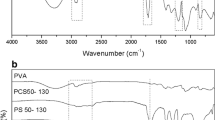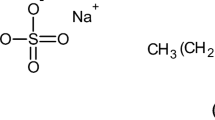Abstract
Hydrophobically associating water-soluble polymers (HAWSPs), which possess surfactant and polymer properties, are extensively studied. This research work presents a novel HAWSP, poly(acrylic acid-alkyl polyoxyethylene acrylate) (P(AA-AAEOn)), synthesized by aqueous polymerization of acrylic acid and alkyl polyoxyethylene acrylate (AAEOn) with various ethoxy groups. The structure of P(AA-AAEOn) was characterized using Fourier transform infrared (FTIR) and nuclear magnetic resonance (NMR) spectroscopies. The association behavior in the solution was also evaluated through surface tension, dynamic light scattering, and rheology measurements. The findings exhibited that P(AA-AAEOn) demonstrated noteworthy surface activity, which was amplified as the proportion of the hydrophobic group increased and could effectively reduce the water surface tension. When the concentration reached 0.01%, P(AA-AAEOn) in the solution changed from intramolecular association to intermolecular association. Additionally, P(AA-AAEOn) manifested notable shear resistance, shear recovery, and viscoelasticity, transitioned from energy elasticity to entropy elasticity in P(AA-AAEOn) molecules between 25 and 35 ℃. The experimental phenomena and mechanisms resulting from the association behavior of polymer molecules have undergone careful analysis. The elastic conversion of polymer molecules at varying temperatures is a noteworthy finding, which has not been extensively documented in earlier research works. A detailed analysis of this phenomenon has been conducted. However, further research is crucial to establish the prevalence of this phenomenon in HAWSPs.
Graphical abstract








Similar content being viewed by others
Data availability
All data, models, and code generated or used during the study appeared in the submitted article.
References
Bai CC, Ke YC, Hu X, Xing L, Zhao Y, Lu S, Lin Y (2020) Preparation and properties of amphiphilic hydrophobically associative polymer/montmorillonite nanocomposites. R Soc Open Sci 7:200199
Zhang M, Kang WL, Yang HB, Zhou BB, Li Z, He YQ, Yurievich KG, Viktorovich LA (2021) De-emulsification performance and mechanism of β-CD reverse demulsifier for amphiphilic polymer oil in water (O/W) emulsion. J Mol Liq 342:117441
Du G, Giudice AD, Alfredsson V, Carnerup AM, Pavel NV, Loh W, Masci G, Nyström B, Galantini L, Schillén K (2020) Effect of temperature on the association behavior in aqueous mixtures of an oppositely charged amphiphilic block copolymer and bile salt. Polymer 206:122871
Wever D, Picchioni F, Broekhuis AA (2011) Polymers for enhanced oil recovery: a paradigm for structure-property relationship in aqueous solution. Prog Polym Sci 36:1558–1628
Liang Y, Guo Y, Yang X, Feng R, Zhang X, Li H (2019) Insights on the interaction between sodium dodecyl sulfate and partially hydrolyzed microblock hydrophobically associating polyacrylamides in different polymer concentration regimes. Colloids Surf A 572:152–166
Kakati A, Kumar G, Sangwai JS (2020) Low salinity polymer flooding: effect on polymer rheology, injectivity, retention and oil recovery efficiency. Energy Fuels 34:5715–5732
Zhao Y, Peng F, Ke Y (2021) Design and characterization of oil-in-water nanoemulsion for enhanced oil recovery stabilized by amphiphilic copolymer, nonionic surfactant, and LAPONITE RD. RSC Adv 11:1952–1959
Zhu S, Liu Z, Luo T, Shi L, Ye Z (2021) Solution properties and seepage characteristics of a dendritic hydrophobically associating polymer. J Polym Res 28:226
Chassenieux C, Nicolai T, Benyahia L (2011) Rheology of associative polymer solutions. Curr Opin Colloid Interface Sci 16:18–26
Zhi JQ, Liu YK, Chen JF, Bo LF, Qu GH, Jiang N, He WZ (2023) Preparation and performance evaluation of a temperature and salt resistant hydrophobic associative weak polymer gel system. Molecules 28:3125
Bagheri M, Shateri S (2012) Thermosensitive nanosized micelles from cholesteryl-modified hydroxypropyl cellulose as a novel carrier of hydrophobic drugs. Iran Polym J 21:365–373
Wan T, Li R, Wu D, Hu Z, Xu M, Cheng W, Zou C (2014) Rheological behaviors and structure of hydrophobically associating AM-SMA copolymers synthesized by microemulsion polymerization. Polym Bull 71:2819–2831
Zhang H, Yu L, Ding JD (2008) Roles of hydrophilic homopolymers on the hydrophobic association induced physical gelling of amphiphilic block copolymers in water. Macromolecules 41:6493–6499
Afolabi RO, Oluyemi GF, Officer S, Ugwu JO (2019) Hydrophobically associating polymers for enhanced oil recovery-Part A: a review on the effects of some key reservoir conditions. J Petrol Sci Eng 180:681–698
Xu H, Li ZW, Wang CY, Wang ZF, Yu RJ, Tan YB (2023) Synthesis and application of amphiphilic copolymer as demulsifier for super heavy oil emulsions. Colloid Surface A 669:131498
Percebom AM, Loh W (2016) Controlling the phase structures of polymer/surfactant complexes by changing macromolecular architecture and adding n-alcohols. J Colloid Interface Sci 466:377–387
Harrison A, Tang C (2021) Amphiphilic polymer nanoreactors for multiple step, one-pot reactions and spontaneous product separation. Polymers 13:1992
Zhao H, Kang W, Yang H, Huang Z, Zhou B, Sarsenbekuly B (2021) Emulsification and stabilization mechanism of crude oil emulsion by surfactant synergistic amphiphilic polymer system. Colloids Surf A 609:125726
Zhou B, Kang W, Yang H, Li Z, Zhang H, Zhang M, Xie A, Sun Z, Sarsenbekuly B (2021) The shear stability mechanism of cyclodextrin polymer and amphiphilic polymer inclusion gels. J Mol Liq 328:115399
Liu H, Jiang A, Jian G, Uhrich KE (1999) Unimolecular micelles: synthesis and characterization of amphiphilic polymer systems. J Polym Sci Part A Polym Chem 37:703–711
Lu Y, Meng Z, Gao K, Hou J, Wu H, Kang W (2019) Interaction of amphiphilic polymers with medium-chain fatty alcohols to enhance rheological performance and mobility control ability. Energ Fuel 33:6273–6282
Zhang Q, Gou S, Zhao L, Fei Y, Zhou L, Li S, Wu Y, Guo Q (2018) Solution behavior of water-soluble poly(acrylamide-co-sulfobetaine) with intensive antisalt performance as an enhanced oil-recovery chemical. J Appl Polym Sci 135:46235
Chi N, Liu J, Lei M, Feng L (2023) Preparation of amphiphilic cationic polyacrylamide (CPAM) with cationic microblock structure to enhance printing and dyeing sludge dewatering and condition performance. Environ Sci Pollut Res 30:13079–13093
Jiang XY, Li YJ, Lu GL, Huang XY (2013) A novel poly(N-vinylcaprolactam)-based well-defined amphiphilic graft copolymer synthesized by successive RAFT and ATRP. Polym Chem 4:1402–1411
Piculell L (2013) Understanding and exploiting the phase behavior of mixtures of oppositely charged polymers and surfactants in water. Langmuir 29:10313–10329
Chakraborty I, Chakraborty T, Moulik SP (2013) JR 400-NaAOT interaction: a detailed thermodynamic study of polymer-surfactant interaction bearing opposite charges. Colloid Polym Sci 291:1939–1948
Roy A, Comesse S, Grisel M, Hucher N, Souguir Z, Renou F (2014) Hydrophobically modified xanthan: an amphiphilic but not associative polymer. Biomacromol 15:1160–1170
Zhu Z, Kou H (2022) The effect of NaCl on the solution properties of a betaine-type amphiphilic polymer and its performance enhancement mechanism. Colloid Polym Sci 300:69–81
Larson RG (2015) Constitutive equations for thixotropic fluids. J Rheol 59:595–611
Yang H, Zhang H, Zheng W, Li X, Wang F, Li X, Zhang D, Turtabayev S, Kang W (2021) Research on synthesis and salt thickening behavior of a binary copolymer amphiphilic polymer. J Petrol Sci Eng 204:108713
Shi SL, Sun JS, Lv KH, Liu JP, Bai YR, Wang JT, Huang XB, Jin JF, Li J (2023) Fracturing fluid polymer thickener with superior temperature, salt and shear resistance properties from the synergistic effect of double-tail hydrophobic monomer and nonionic polymerizable surfactant. Molecules 28:5104
Acknowledgements
This work is supported by the Natural Science Foundation of Shandong Province (ZR2022MB148) and the Fundamental Research Funds for the Central Universities (20CX05015A, 22CX03024A).
Author information
Authors and Affiliations
Contributions
XW: Conceptualization, Data curation, Formal analysis, Investigation, Methodology, Writing-original draft, Writing-review and editing. ZZ Conceptualization, Methodology, Formal analysis, Investigation, Funding acquisition, Project administration, Writing-original draft, Writing-review and editing, Visualization, Supervision. YZ Data curation, Methodology. GZ Writing-review and editing. FW Methodology, Investigation, Project administration, Writing-review and editing, Visualization.
Corresponding authors
Ethics declarations
Conflict of interest
The authors declare that they have no known competing financial interests or personal relationships that could have appeared to influence the study reported in this work.
Supplementary Information
Below is the link to the electronic supplementary material.
Rights and permissions
Springer Nature or its licensor (e.g. a society or other partner) holds exclusive rights to this article under a publishing agreement with the author(s) or other rightsholder(s); author self-archiving of the accepted manuscript version of this article is solely governed by the terms of such publishing agreement and applicable law.
About this article
Cite this article
Wang, X., Zhang, Z., Zhang, Y. et al. Study on sassociation behavior and solution properties of poly(acrylic acid-alkyl polyoxyethylene acrylate) amphiphilic copolymers. Iran Polym J (2024). https://doi.org/10.1007/s13726-024-01296-8
Received:
Accepted:
Published:
DOI: https://doi.org/10.1007/s13726-024-01296-8




